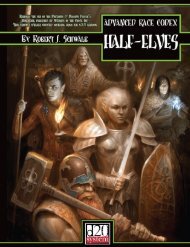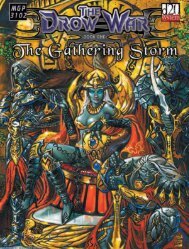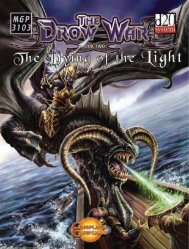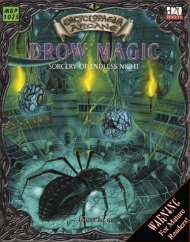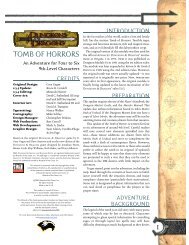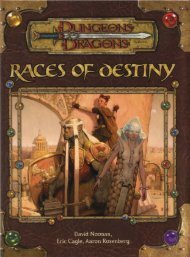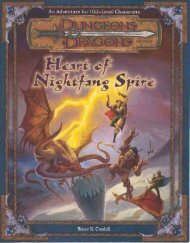Create successful ePaper yourself
Turn your PDF publications into a flip-book with our unique Google optimized e-Paper software.
<strong>The</strong> one near constant of Kez’Skul is that he hates to lose<br />
worshippers. Though he has kept his aspect as Vermthizzl<br />
(see page 48) secret even from his highest clergy, his<br />
annoyance at the loss of potential worshippers is at least<br />
part of the reason he created this aspect of himself for the<br />
Pol’Tah (see page 115). <strong>Of</strong> course, even that reason is<br />
overshadowed by the immensity of the joke he has<br />
perpetrated upon them.<br />
Religious Observances<br />
Kez’Skul revels in intricate falsehoods<br />
and well-crafted deceit. He has<br />
no interest in crudely obvious<br />
or lighthearted jokes, which<br />
is good, as the drow are<br />
hardly given to such pursuits.<br />
Rather, he prefers jests which<br />
in cultures other than the drow<br />
would be considered cruelty. For<br />
example, a worshipper of Kez’Skul<br />
who is able to craft an intricate web<br />
of lies, convincing a wealthy merchant<br />
his fortunes are failing and poverty is<br />
imminent before driving him to suicide, all while<br />
his fortunes are in fact growing, would receive great<br />
favour in the eyes of Kez’Skul.<br />
<strong>The</strong> cult of the Deceiver does practice sacrifice, but it is<br />
less common than in most other drow faiths and certainly<br />
not the nearly-constant practice it is in the church of the<br />
Dark Mother. Kez’Skul has no interest in receiving<br />
the soul of a sacrifice brought kicking and screaming to<br />
the altar. Instead, sacrifices to the Trickster of the drow<br />
must be brought to the altar more subtly. Ideally, this<br />
involves tricking the potential sacrifice into freely making<br />
himself a victim to the Deceiver, or, even more satisfying,<br />
to convince a potential sacrifice to lie down on the altar<br />
without even realising what fate is in store for him.<br />
Obviously, this is an extremely difficult task for the clergy<br />
to accomplish, particularly given the suspicious nature of<br />
the drow and the fact that Kez’Skul’s preferences for his<br />
sacrifices are known in drow society. <strong>The</strong> clergy of the<br />
Deceiver are themselves excellent at deceit, however, and<br />
they are sometimes successful.<br />
Temples<br />
<strong>The</strong> temples of Kez’Skul the Deceiver have nothing in<br />
common with one another save their utter randomness.<br />
<strong>The</strong>y are large complexes but, as space is at a premium<br />
in drow cities, most of their volume is vertical. That is,<br />
they are built upward as high as the engineering arts of the<br />
drow can manage and delve even further than that into the<br />
ground, precariously perched upon a labyrinth of tunnels<br />
and catacombs. <strong>The</strong>y never have a single definable shape;<br />
they are not ‘round’ or ‘square’ but rather seem almost to<br />
have been built haphazardly. In those drow cities lucky<br />
enough to have a generously abundant air flow,<br />
temples usually have a large, constantly burning gas<br />
flame at the apex of the roof.<br />
Inside, the temples are a warren of chaos. Secret<br />
passageways, false doors and rotating<br />
walls are the norm. A stranger to the<br />
temple will quickly become hopelessly<br />
lost in this intentionally-confusing maze,<br />
wandering aimlessly until he is either<br />
found by the clergy, makes his way<br />
out or meets his end in one of the many<br />
traps the worshippers of Kez’Skul build<br />
into his temples. A new recruit to the<br />
priesthood usually needs months to<br />
memorise the intricacies and<br />
pitfalls of the temple, during<br />
which time he is often, but<br />
not always, accompanied by<br />
a senior priest for his own<br />
protection.<br />
Clergy<br />
Clergy of the Trickster wear ceremonial vestments<br />
crafted of a specially-treated na’orsuin, which seems to<br />
shift colours depending on the light. While in the temple,<br />
all clergy wear a mask made of the same na’orsuin which<br />
conceals the face completely.<br />
<strong>The</strong> priests and priestesses of Kez’Skul the Deceiver are<br />
taken from all walks of life in drow culture, for the church<br />
believes that each strata of society possesses its own gifts<br />
for deceit and trickery. Males and females exist in roughly<br />
equal numbers in the priesthood, a surprise to some who<br />
assume that females would be more adept at the work of<br />
the Trickster. Though the clergy of Kez’Skul move about<br />
freely and often outside the temple, they rarely do so in<br />
the masks and colour-shifting garments of their cult. This<br />
is not because of any particular fear, but simply to make it<br />
easier to keep themselves anonymous.<br />
Though most drow cults and churches involve themselves<br />
somehow in the ongoing internecine drow struggle known<br />
either as the Game of Bones or the Sheathed War, the cult<br />
of Kez’Skul the Deceiver is almost certainly the most<br />
active. <strong>The</strong> Game of Bones is based on webs of lies, deceit,<br />
falsehood and innuendo and the priests and priestesses of<br />
the Trickster have a natural talent at such pursuits that<br />
makes them a dangerous foe.<br />
37




